Network Management in Organisations: Ethical use of Wearable Tech
VerifiedAdded on 2023/04/20
|5
|1421
|336
Essay
AI Summary
This essay examines the ethical challenges posed by the use of wearable technologies in organizational network management, focusing on privacy concerns, data security, and the potential for misuse of confidential information. It identifies key ethical issues such as the leakage of sensitive company data and the violation of informed consent, analyzing the impact of wearable devices on employee monitoring and data breaches. The essay evaluates the benefits and drawbacks of wearable technology, emphasizing the need for organizations to carefully consider the implications before implementation. It concludes that a thorough analysis of pros and cons is essential to determine whether wearable devices are beneficial or detrimental to the organization, advocating for policies that prioritize data privacy and security.
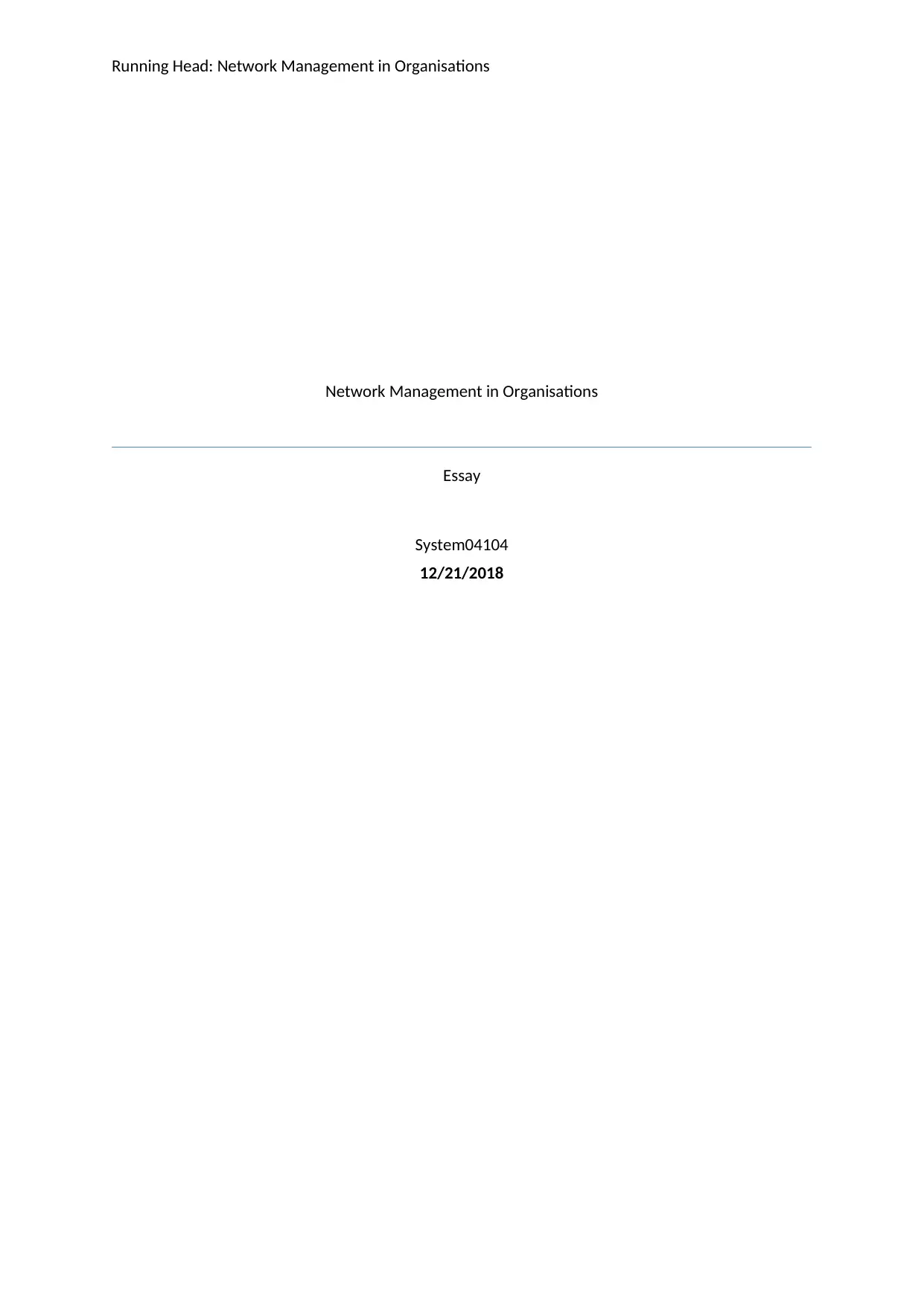
Running Head: Network Management in Organisations
Network Management in Organisations
Essay
System04104
12/21/2018
Network Management in Organisations
Essay
System04104
12/21/2018
Paraphrase This Document
Need a fresh take? Get an instant paraphrase of this document with our AI Paraphraser
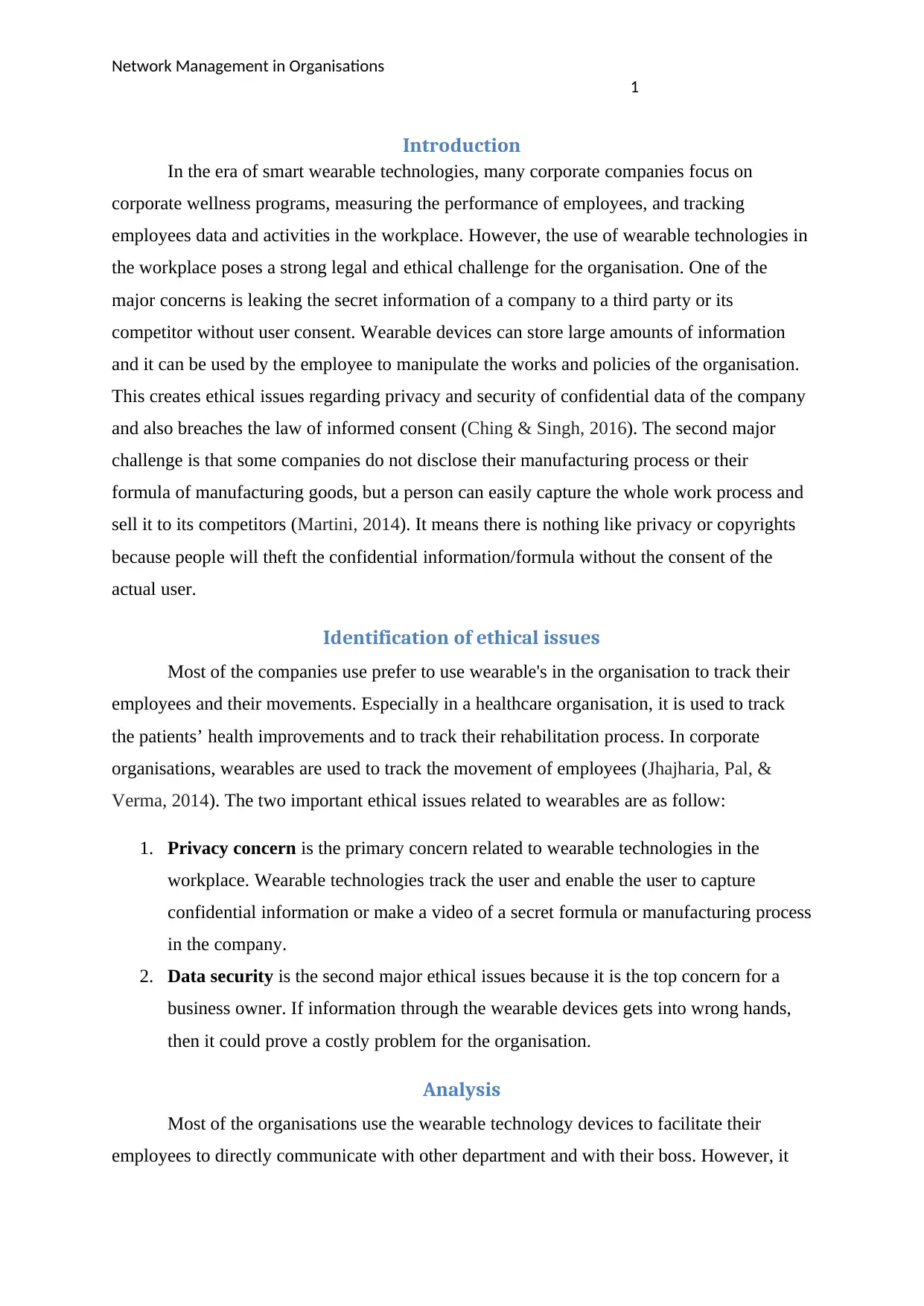
Network Management in Organisations
1
Introduction
In the era of smart wearable technologies, many corporate companies focus on
corporate wellness programs, measuring the performance of employees, and tracking
employees data and activities in the workplace. However, the use of wearable technologies in
the workplace poses a strong legal and ethical challenge for the organisation. One of the
major concerns is leaking the secret information of a company to a third party or its
competitor without user consent. Wearable devices can store large amounts of information
and it can be used by the employee to manipulate the works and policies of the organisation.
This creates ethical issues regarding privacy and security of confidential data of the company
and also breaches the law of informed consent (Ching & Singh, 2016). The second major
challenge is that some companies do not disclose their manufacturing process or their
formula of manufacturing goods, but a person can easily capture the whole work process and
sell it to its competitors (Martini, 2014). It means there is nothing like privacy or copyrights
because people will theft the confidential information/formula without the consent of the
actual user.
Identification of ethical issues
Most of the companies use prefer to use wearable's in the organisation to track their
employees and their movements. Especially in a healthcare organisation, it is used to track
the patients’ health improvements and to track their rehabilitation process. In corporate
organisations, wearables are used to track the movement of employees (Jhajharia, Pal, &
Verma, 2014). The two important ethical issues related to wearables are as follow:
1. Privacy concern is the primary concern related to wearable technologies in the
workplace. Wearable technologies track the user and enable the user to capture
confidential information or make a video of a secret formula or manufacturing process
in the company.
2. Data security is the second major ethical issues because it is the top concern for a
business owner. If information through the wearable devices gets into wrong hands,
then it could prove a costly problem for the organisation.
Analysis
Most of the organisations use the wearable technology devices to facilitate their
employees to directly communicate with other department and with their boss. However, it
1
Introduction
In the era of smart wearable technologies, many corporate companies focus on
corporate wellness programs, measuring the performance of employees, and tracking
employees data and activities in the workplace. However, the use of wearable technologies in
the workplace poses a strong legal and ethical challenge for the organisation. One of the
major concerns is leaking the secret information of a company to a third party or its
competitor without user consent. Wearable devices can store large amounts of information
and it can be used by the employee to manipulate the works and policies of the organisation.
This creates ethical issues regarding privacy and security of confidential data of the company
and also breaches the law of informed consent (Ching & Singh, 2016). The second major
challenge is that some companies do not disclose their manufacturing process or their
formula of manufacturing goods, but a person can easily capture the whole work process and
sell it to its competitors (Martini, 2014). It means there is nothing like privacy or copyrights
because people will theft the confidential information/formula without the consent of the
actual user.
Identification of ethical issues
Most of the companies use prefer to use wearable's in the organisation to track their
employees and their movements. Especially in a healthcare organisation, it is used to track
the patients’ health improvements and to track their rehabilitation process. In corporate
organisations, wearables are used to track the movement of employees (Jhajharia, Pal, &
Verma, 2014). The two important ethical issues related to wearables are as follow:
1. Privacy concern is the primary concern related to wearable technologies in the
workplace. Wearable technologies track the user and enable the user to capture
confidential information or make a video of a secret formula or manufacturing process
in the company.
2. Data security is the second major ethical issues because it is the top concern for a
business owner. If information through the wearable devices gets into wrong hands,
then it could prove a costly problem for the organisation.
Analysis
Most of the organisations use the wearable technology devices to facilitate their
employees to directly communicate with other department and with their boss. However, it
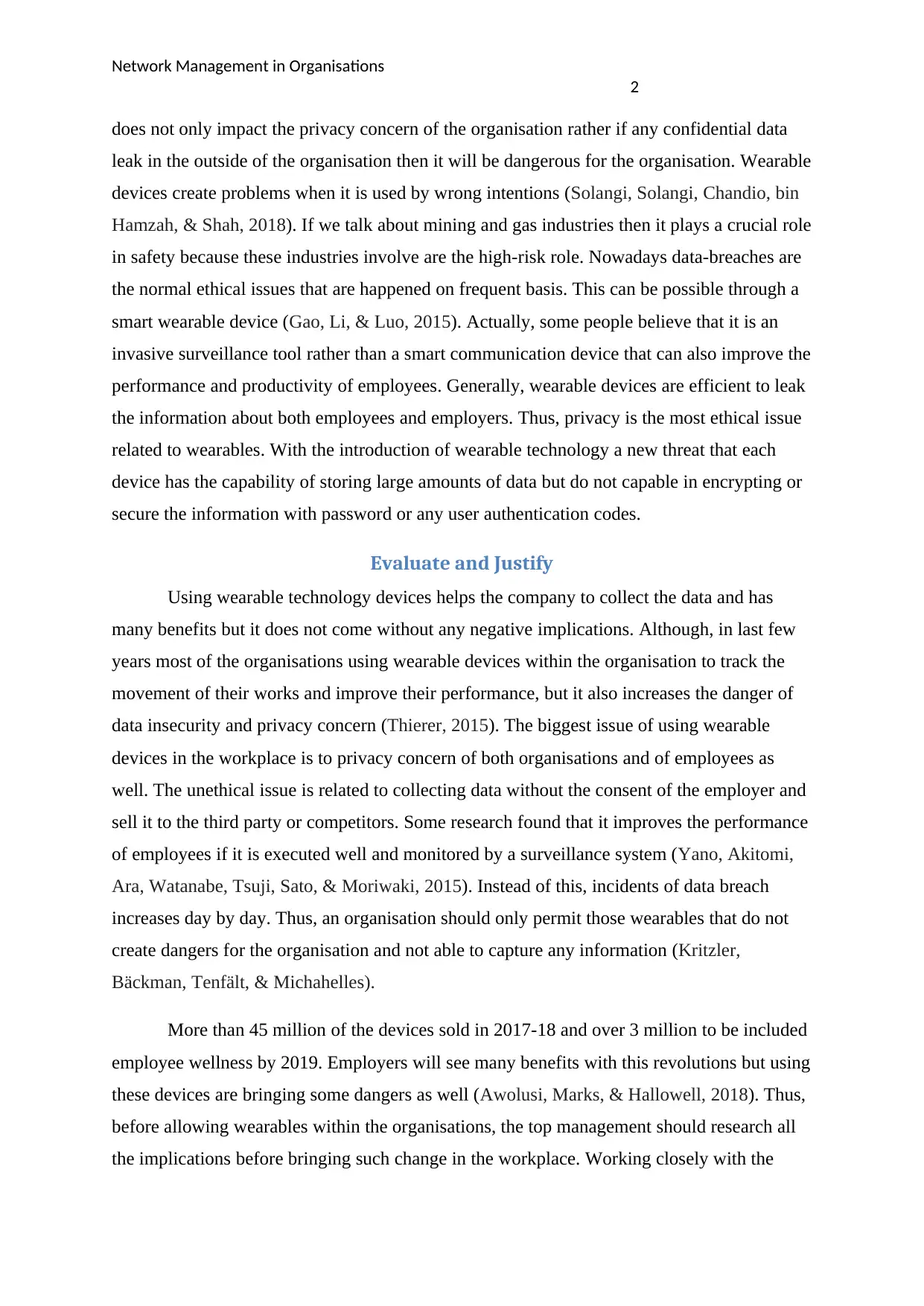
Network Management in Organisations
2
does not only impact the privacy concern of the organisation rather if any confidential data
leak in the outside of the organisation then it will be dangerous for the organisation. Wearable
devices create problems when it is used by wrong intentions (Solangi, Solangi, Chandio, bin
Hamzah, & Shah, 2018). If we talk about mining and gas industries then it plays a crucial role
in safety because these industries involve are the high-risk role. Nowadays data-breaches are
the normal ethical issues that are happened on frequent basis. This can be possible through a
smart wearable device (Gao, Li, & Luo, 2015). Actually, some people believe that it is an
invasive surveillance tool rather than a smart communication device that can also improve the
performance and productivity of employees. Generally, wearable devices are efficient to leak
the information about both employees and employers. Thus, privacy is the most ethical issue
related to wearables. With the introduction of wearable technology a new threat that each
device has the capability of storing large amounts of data but do not capable in encrypting or
secure the information with password or any user authentication codes.
Evaluate and Justify
Using wearable technology devices helps the company to collect the data and has
many benefits but it does not come without any negative implications. Although, in last few
years most of the organisations using wearable devices within the organisation to track the
movement of their works and improve their performance, but it also increases the danger of
data insecurity and privacy concern (Thierer, 2015). The biggest issue of using wearable
devices in the workplace is to privacy concern of both organisations and of employees as
well. The unethical issue is related to collecting data without the consent of the employer and
sell it to the third party or competitors. Some research found that it improves the performance
of employees if it is executed well and monitored by a surveillance system (Yano, Akitomi,
Ara, Watanabe, Tsuji, Sato, & Moriwaki, 2015). Instead of this, incidents of data breach
increases day by day. Thus, an organisation should only permit those wearables that do not
create dangers for the organisation and not able to capture any information (Kritzler,
Bäckman, Tenfält, & Michahelles).
More than 45 million of the devices sold in 2017-18 and over 3 million to be included
employee wellness by 2019. Employers will see many benefits with this revolutions but using
these devices are bringing some dangers as well (Awolusi, Marks, & Hallowell, 2018). Thus,
before allowing wearables within the organisations, the top management should research all
the implications before bringing such change in the workplace. Working closely with the
2
does not only impact the privacy concern of the organisation rather if any confidential data
leak in the outside of the organisation then it will be dangerous for the organisation. Wearable
devices create problems when it is used by wrong intentions (Solangi, Solangi, Chandio, bin
Hamzah, & Shah, 2018). If we talk about mining and gas industries then it plays a crucial role
in safety because these industries involve are the high-risk role. Nowadays data-breaches are
the normal ethical issues that are happened on frequent basis. This can be possible through a
smart wearable device (Gao, Li, & Luo, 2015). Actually, some people believe that it is an
invasive surveillance tool rather than a smart communication device that can also improve the
performance and productivity of employees. Generally, wearable devices are efficient to leak
the information about both employees and employers. Thus, privacy is the most ethical issue
related to wearables. With the introduction of wearable technology a new threat that each
device has the capability of storing large amounts of data but do not capable in encrypting or
secure the information with password or any user authentication codes.
Evaluate and Justify
Using wearable technology devices helps the company to collect the data and has
many benefits but it does not come without any negative implications. Although, in last few
years most of the organisations using wearable devices within the organisation to track the
movement of their works and improve their performance, but it also increases the danger of
data insecurity and privacy concern (Thierer, 2015). The biggest issue of using wearable
devices in the workplace is to privacy concern of both organisations and of employees as
well. The unethical issue is related to collecting data without the consent of the employer and
sell it to the third party or competitors. Some research found that it improves the performance
of employees if it is executed well and monitored by a surveillance system (Yano, Akitomi,
Ara, Watanabe, Tsuji, Sato, & Moriwaki, 2015). Instead of this, incidents of data breach
increases day by day. Thus, an organisation should only permit those wearables that do not
create dangers for the organisation and not able to capture any information (Kritzler,
Bäckman, Tenfält, & Michahelles).
More than 45 million of the devices sold in 2017-18 and over 3 million to be included
employee wellness by 2019. Employers will see many benefits with this revolutions but using
these devices are bringing some dangers as well (Awolusi, Marks, & Hallowell, 2018). Thus,
before allowing wearables within the organisations, the top management should research all
the implications before bringing such change in the workplace. Working closely with the
⊘ This is a preview!⊘
Do you want full access?
Subscribe today to unlock all pages.

Trusted by 1+ million students worldwide
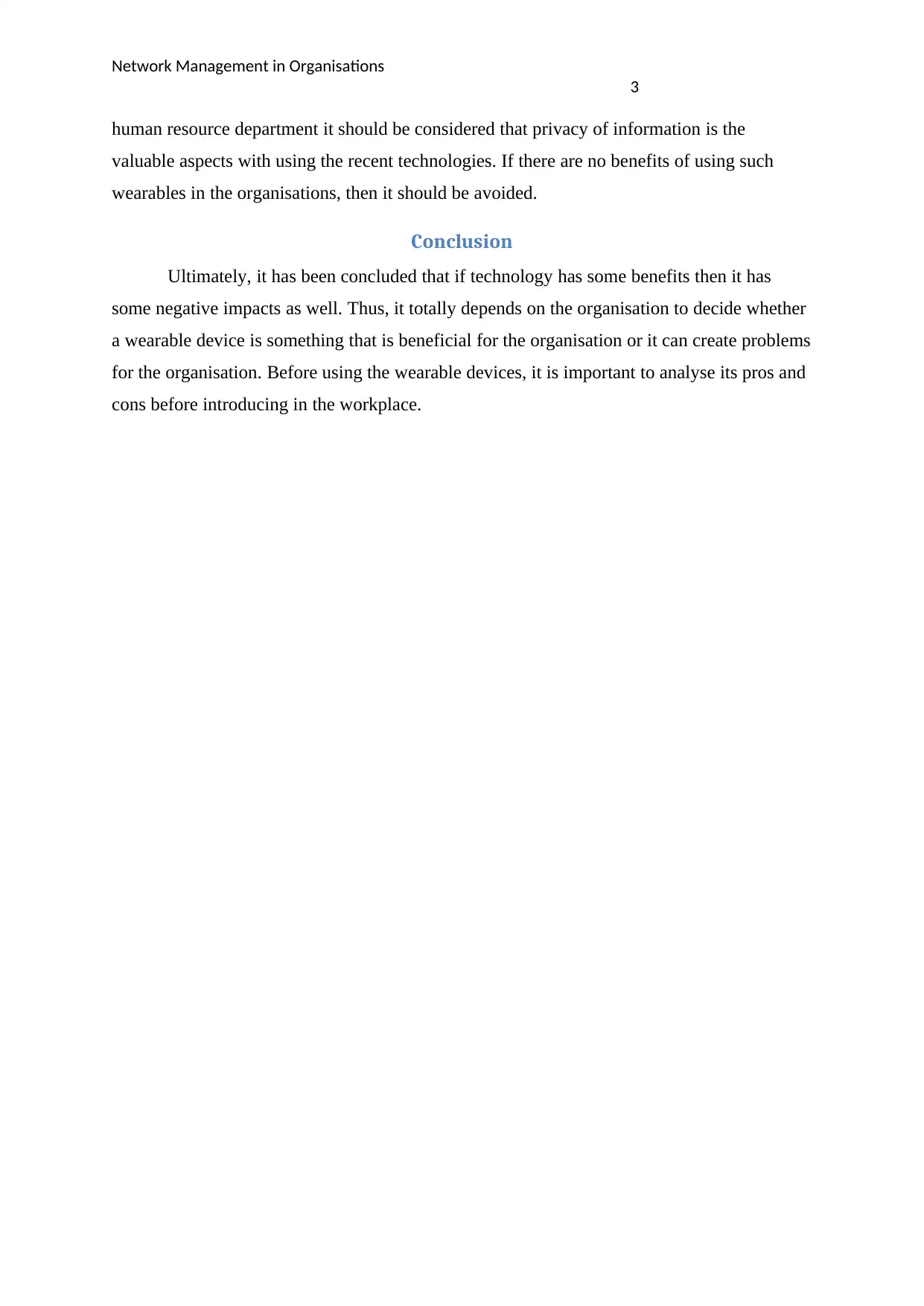
Network Management in Organisations
3
human resource department it should be considered that privacy of information is the
valuable aspects with using the recent technologies. If there are no benefits of using such
wearables in the organisations, then it should be avoided.
Conclusion
Ultimately, it has been concluded that if technology has some benefits then it has
some negative impacts as well. Thus, it totally depends on the organisation to decide whether
a wearable device is something that is beneficial for the organisation or it can create problems
for the organisation. Before using the wearable devices, it is important to analyse its pros and
cons before introducing in the workplace.
3
human resource department it should be considered that privacy of information is the
valuable aspects with using the recent technologies. If there are no benefits of using such
wearables in the organisations, then it should be avoided.
Conclusion
Ultimately, it has been concluded that if technology has some benefits then it has
some negative impacts as well. Thus, it totally depends on the organisation to decide whether
a wearable device is something that is beneficial for the organisation or it can create problems
for the organisation. Before using the wearable devices, it is important to analyse its pros and
cons before introducing in the workplace.
Paraphrase This Document
Need a fresh take? Get an instant paraphrase of this document with our AI Paraphraser
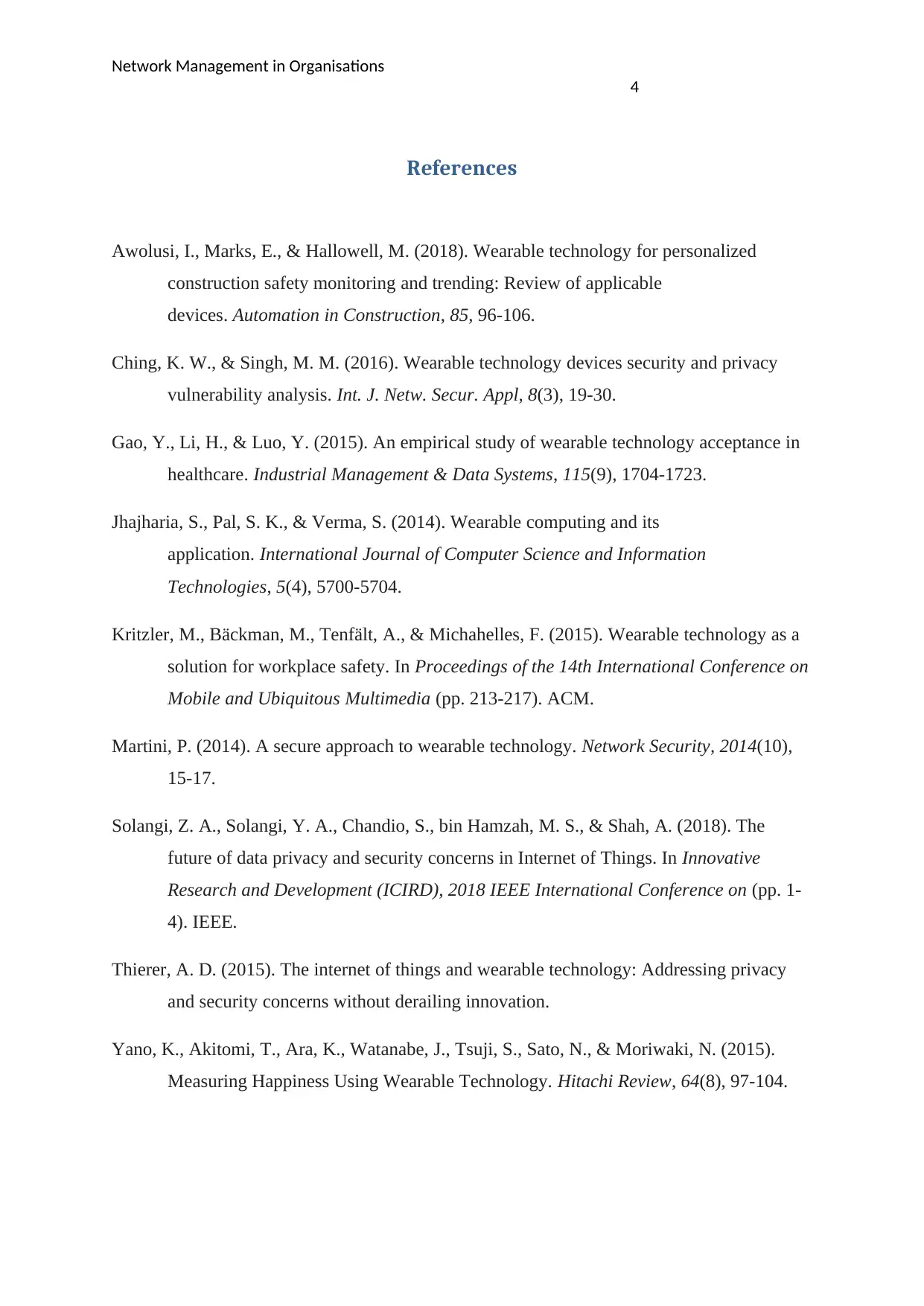
Network Management in Organisations
4
References
Awolusi, I., Marks, E., & Hallowell, M. (2018). Wearable technology for personalized
construction safety monitoring and trending: Review of applicable
devices. Automation in Construction, 85, 96-106.
Ching, K. W., & Singh, M. M. (2016). Wearable technology devices security and privacy
vulnerability analysis. Int. J. Netw. Secur. Appl, 8(3), 19-30.
Gao, Y., Li, H., & Luo, Y. (2015). An empirical study of wearable technology acceptance in
healthcare. Industrial Management & Data Systems, 115(9), 1704-1723.
Jhajharia, S., Pal, S. K., & Verma, S. (2014). Wearable computing and its
application. International Journal of Computer Science and Information
Technologies, 5(4), 5700-5704.
Kritzler, M., Bäckman, M., Tenfält, A., & Michahelles, F. (2015). Wearable technology as a
solution for workplace safety. In Proceedings of the 14th International Conference on
Mobile and Ubiquitous Multimedia (pp. 213-217). ACM.
Martini, P. (2014). A secure approach to wearable technology. Network Security, 2014(10),
15-17.
Solangi, Z. A., Solangi, Y. A., Chandio, S., bin Hamzah, M. S., & Shah, A. (2018). The
future of data privacy and security concerns in Internet of Things. In Innovative
Research and Development (ICIRD), 2018 IEEE International Conference on (pp. 1-
4). IEEE.
Thierer, A. D. (2015). The internet of things and wearable technology: Addressing privacy
and security concerns without derailing innovation.
Yano, K., Akitomi, T., Ara, K., Watanabe, J., Tsuji, S., Sato, N., & Moriwaki, N. (2015).
Measuring Happiness Using Wearable Technology. Hitachi Review, 64(8), 97-104.
4
References
Awolusi, I., Marks, E., & Hallowell, M. (2018). Wearable technology for personalized
construction safety monitoring and trending: Review of applicable
devices. Automation in Construction, 85, 96-106.
Ching, K. W., & Singh, M. M. (2016). Wearable technology devices security and privacy
vulnerability analysis. Int. J. Netw. Secur. Appl, 8(3), 19-30.
Gao, Y., Li, H., & Luo, Y. (2015). An empirical study of wearable technology acceptance in
healthcare. Industrial Management & Data Systems, 115(9), 1704-1723.
Jhajharia, S., Pal, S. K., & Verma, S. (2014). Wearable computing and its
application. International Journal of Computer Science and Information
Technologies, 5(4), 5700-5704.
Kritzler, M., Bäckman, M., Tenfält, A., & Michahelles, F. (2015). Wearable technology as a
solution for workplace safety. In Proceedings of the 14th International Conference on
Mobile and Ubiquitous Multimedia (pp. 213-217). ACM.
Martini, P. (2014). A secure approach to wearable technology. Network Security, 2014(10),
15-17.
Solangi, Z. A., Solangi, Y. A., Chandio, S., bin Hamzah, M. S., & Shah, A. (2018). The
future of data privacy and security concerns in Internet of Things. In Innovative
Research and Development (ICIRD), 2018 IEEE International Conference on (pp. 1-
4). IEEE.
Thierer, A. D. (2015). The internet of things and wearable technology: Addressing privacy
and security concerns without derailing innovation.
Yano, K., Akitomi, T., Ara, K., Watanabe, J., Tsuji, S., Sato, N., & Moriwaki, N. (2015).
Measuring Happiness Using Wearable Technology. Hitachi Review, 64(8), 97-104.
1 out of 5
Related Documents
Your All-in-One AI-Powered Toolkit for Academic Success.
+13062052269
info@desklib.com
Available 24*7 on WhatsApp / Email
![[object Object]](/_next/static/media/star-bottom.7253800d.svg)
Unlock your academic potential
Copyright © 2020–2025 A2Z Services. All Rights Reserved. Developed and managed by ZUCOL.



